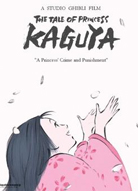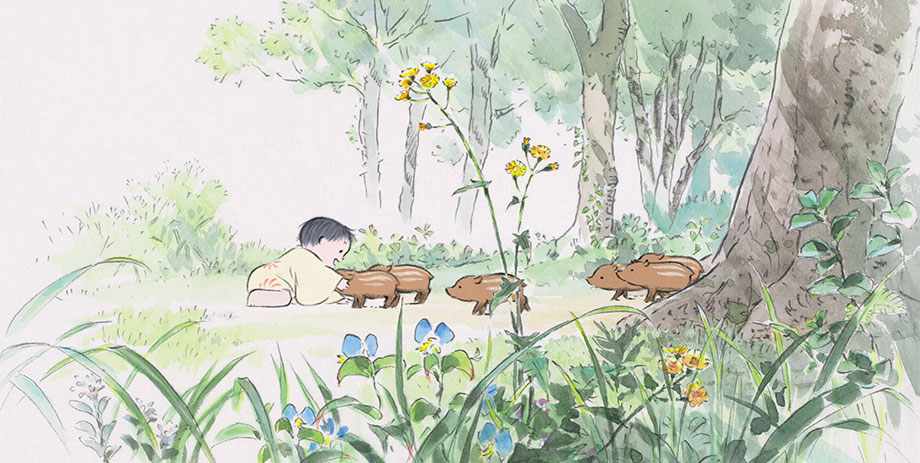 Tim here. This week's look at one of the 2014 Best Animated Feature Oscar contenders takes us someplace entirely new: to a film that might actually be able to swing a nomination. The film is The Tale of the Princess Kaguya, the penultimate film made by the late Studio Ghibli, and probably the final work directed by the great Takahata Isao, who hasn't officially announced his retirement, like friend and colleague Hayao Miyazaki; but when a director is 79 years old and has reached the "enormous gaps between features" stage of his career (his previous film, My Neighbors the Yamadas, came out in 1999), it's time to make some assumptions.
Tim here. This week's look at one of the 2014 Best Animated Feature Oscar contenders takes us someplace entirely new: to a film that might actually be able to swing a nomination. The film is The Tale of the Princess Kaguya, the penultimate film made by the late Studio Ghibli, and probably the final work directed by the great Takahata Isao, who hasn't officially announced his retirement, like friend and colleague Hayao Miyazaki; but when a director is 79 years old and has reached the "enormous gaps between features" stage of his career (his previous film, My Neighbors the Yamadas, came out in 1999), it's time to make some assumptions.
If it's a valedictory work that Princess Kaguya is to be, it's a brilliant one, right down to an ending about the pain of saying farewell when we're not ready to. The film adapts "The Tale of the Bamboo Cutter", a folktale that is thought to be the oldest extant work of Japanese literature, telling of a little girl found in a glowing stalk of bamboo by an old bamboo cutter one day. Convinced by this and other signs that he has been tasked by giving her the life a noble princess, the bamboo cutter focuses on pushing her into the upper crusts of society despite how clearly the girl, Kaguya, resents this life, and would prefer to be left in the peaceable wilds of her adoptive home.

It sounds like a fable, because it is, after all, a fable. And one that is brought to life with considerable elegance and beauty by one of the finest animation directors now living. Takahata's career, since helping to co-found Studio Ghibli, has been dominated by stylistic experiments, but never for the sake of pure style. Forever and always, his films have found new aesthetics that are each drawn up from the story he's telling and best suited to making the emotional connections of that one story. In the case of Princess Kaguya, the story is an ancient literary classic, and so it's natural that the visual style he uses in telling it is comparatively old-fashioned: the whole film looks to have been sketched out with brushes and colored pencils, capturing faces and settings with primitive simplicity.

It's not old-fashioned, of course: the film was made entirely on computers, the possibilities of digital image manipulation freeing Takahata to be far more expressionistic in his style than ever before. The results are terrific, using cutting-edge technology to freshen up an old story (but never modernizing it!) in a style that has the elegance of fine art, far more than anything that has been done in a movie of comparative size and mainstream aspiration.
And while Princess Kaguya is beautiful – the most beautiful and distinctive animated film not just of 2014, but the last several years as well – that beauty is always firmly tied to its storytelling aspirations. This isn't Takahata's greatest moment as a storyteller: the 137-minute doesn't rush itself, and sometimes saved from drifting away in a haze of anti-momentum only by abrupt shifts in the narrative focus. It's far more interested in the emotions of its characters, primarily Kaguya, than in the actual plot details of what happens. Here, then, is where the visuals come into play, not just with the simple & tremendously expressive lines used to express complicated, unspoken feelings, but in the use of colors and backdrops as well: the flowing, natural settings for the wild contrast subtly but unmissably with the hard white and grey flatness that defines the urban spaces where Kaguya fails to find happiness or meaning.

The film's depiction of Kaguya's lack of fulfillment and desire for a different life is all the more effective and haunting given that the film never needs to state it, but always teases it out through imagery, through its quiet soundscape, and through Joe Hisaishi's terrific, tearful music (the first time Miyazaki's favorite composer has worked with Takahata). Emotional power through subtle depictions: that's not at all the kind of things we think of in English language animation, but it is one of the things Takahata has always been best at. And in this film, he gets to show off one last time that the things he does best, he does better than virtually anyone.
Oscar chances: Excellent. Nathaniel's predictions are a bit bearish on the film, but it's getting more of GKIDS' support than Song of the Sea (it's also the only film besides The Lego Movie with multiple wins from critics groups, I believe), and that alone is probably just enough to push it into the #5 slot.
